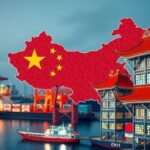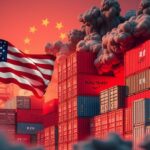Economy
Politics
AFP, ASIA, AUSTRALIA, BEIJING, CHINA, COMMUNIST PARTY, CUBA, DONALD TRUMP, ECONOMY, GEOPOLITICS, HARRY MURPHY CRUISE, JOE BIDEN, LI QIANG, MEXICO, MOODY ' S ANALYTICS, NORTH AMERICA, NPC, OCEANIA, TARIFFS, TRADE, TRUMP, UNITED STATES, US, US-CHINA RELATIONS, WHITE HOUSE
Sophia Klein
China’s Leadership Strategizes Economic Defense Amid US Trade Threats
China’s leadership will meet next week to devise plans for protecting the economy from US tariffs. As Premier Li Qiang outlines growth goals for 2025, analysts expect a target of five percent growth amid significant economic challenges. The unpredictable Trump administration may present further obstacles as China seeks to bolster its technological capabilities and address persistent weaknesses in domestic consumption, most notably linked to the ongoing property crisis.
China’s leadership will gather next week for a series of closed-door meetings aimed at devising strategies to protect its struggling economy from tariffs and trade threats posed by United States President Donald Trump. The “Two Sessions” meetings, consisting of the National People’s Congress and the top advisory body, provide insight into the leadership’s concerns regarding US-China relations, as well as a façade of transparency and accountability in governance.
The meeting will be highlighted by Premier Li Qiang’s presentation of economic growth targets for 2025 during the National People’s Congress opening on Wednesday. Analysts anticipate that the target will likely be set at approximately five percent growth, the same as projected for 2024. This figure is viewed as highly ambitious given the current challenges facing the nation and the government’s reluctance to initiate significant stimulus measures.
Among the pressing issues is the economic strain stemming from a faltering property market, declining consumer spending, high youth unemployment, and tariffs imposed by the US. These compounded challenges have caused significant economic difficulties, described by Harry Murphy Cruise of Moody’s Analytics as a metaphorical migraine for officials tasked with addressing such multifaceted concerns.
The unpredictable nature of President Trump poses additional challenges for China’s economic planners. His recent imposition of a 10 percent tariff on Chinese imports and threats of further increases may disrupt hundreds of billions of dollars in trade. Additionally, the US campaign to disrupt China’s access to high-tech components continues to escalate under President Biden, encouraging China’s push for technological self-sufficiency.
In response to these external pressures, China plans to invest heavily in technological advancements, aiming to foster new economic growth drivers through innovation and commercialization. Reports indicate that Beijing has already dedicated over $47 billion to its largest-ever chip investment fund, highlighting the leadership’s commitment to enhancing domestic technological capabilities.
As economic external shocks increase, it is expected that China may resort to policy measures similar to those employed in previous years, including interest rate cuts, easing local government debt, and expanding subsidy programs. Wang Tao, UBS’s chief China economist, envisions more comprehensive support to be introduced in response to worsening economic conditions later in the year.
Weak domestic consumption remains a significant hurdle, contributing to a deflationary environment and hampering economic recovery. Analysts suggest enhancing existing consumer trade-in programs to stimulate retail spending, although deeper structural issues are believed to be eroding consumer confidence overall.
The ongoing property crisis presents one of the most significant economic challenges, evidenced by declining home prices across various city tiers. Oxford Economics identifies the property sector as a central issue, warning that the ramifications of this crisis are deeply intertwined with other economic factors, thereby complicating any recovery efforts. Policymakers face the formidable task of addressing these interrelated issues this year, striving to restore stability and growth in the economy.
In summary, China’s leadership is preparing to confront significant economic challenges posed by external pressures from tariff threats and dwindling domestic consumption. The forthcoming meetings will play a crucial role in shaping the country’s growth objectives and economic policies. Key issues such as the property crisis and the need for innovation will be emphasized, aiming to fortify China’s economic resilience in the face of a volatile global landscape.
Original Source: www.kpvi.com








Post Comment